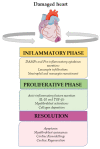Polarizing Macrophage Functional Phenotype to Foster Cardiac Regeneration
- PMID: 37445929
- PMCID: PMC10341872
- DOI: 10.3390/ijms241310747
Polarizing Macrophage Functional Phenotype to Foster Cardiac Regeneration
Abstract
There is an increasing interest in understanding the connection between the immune and cardiovascular systems, which are highly integrated and communicate through finely regulated cross-talking mechanisms. Recent evidence has demonstrated that the immune system does indeed have a key role in the response to cardiac injury and in cardiac regeneration. Among the immune cells, macrophages appear to have a prominent role in this context, with different subtypes described so far that each have a specific influence on cardiac remodeling and repair. Similarly, there are significant differences in how the innate and adaptive immune systems affect the response to cardiac damage. Understanding all these mechanisms may have relevant clinical implications. Several studies have already demonstrated that stem cell-based therapies support myocardial repair. However, the exact role that cardiac macrophages and their modulation may have in this setting is still unclear. The current need to decipher the dual role of immunity in boosting both heart injury and repair is due, at least for a significant part, to unresolved questions related to the complexity of cardiac macrophage phenotypes. The aim of this review is to provide an overview on the role of the immune system, and of macrophages in particular, in the response to cardiac injury and to outline, through the modulation of the immune response, potential novel therapeutic strategies for cardiac regeneration.
Keywords: cardiac regeneration; inflammation; innate immunity; macrophages.
Conflict of interest statement
The authors declare no conflict of interest.
Figures



Similar articles
-
Inflammation in cardiac injury, repair and regeneration.Curr Opin Cardiol. 2015 May;30(3):240-5. doi: 10.1097/HCO.0000000000000158. Curr Opin Cardiol. 2015. PMID: 25807226 Free PMC article. Review.
-
Cortical bone stem cells modify cardiac inflammation after myocardial infarction by inducing a novel macrophage phenotype.Am J Physiol Heart Circ Physiol. 2021 Oct 1;321(4):H684-H701. doi: 10.1152/ajpheart.00304.2021. Epub 2021 Aug 20. Am J Physiol Heart Circ Physiol. 2021. PMID: 34415185 Free PMC article.
-
The Evolving Roles of Cardiac Macrophages in Homeostasis, Regeneration, and Repair.Int J Mol Sci. 2021 Jul 25;22(15):7923. doi: 10.3390/ijms22157923. Int J Mol Sci. 2021. PMID: 34360689 Free PMC article. Review.
-
Macrophages and regeneration: Lessons from the heart.Semin Cell Dev Biol. 2016 Oct;58:26-33. doi: 10.1016/j.semcdb.2016.04.012. Epub 2016 Apr 23. Semin Cell Dev Biol. 2016. PMID: 27118656 Review.
-
Regenerative cross talk between cardiac cells and macrophages.Am J Physiol Heart Circ Physiol. 2021 Jun 1;320(6):H2211-H2221. doi: 10.1152/ajpheart.00056.2021. Epub 2021 Mar 26. Am J Physiol Heart Circ Physiol. 2021. PMID: 33769920 Free PMC article.
Cited by
-
Macrophage-based therapeutic approaches for cardiovascular diseases.Basic Res Cardiol. 2024 Feb;119(1):1-33. doi: 10.1007/s00395-023-01027-9. Epub 2024 Jan 3. Basic Res Cardiol. 2024. PMID: 38170281 Free PMC article. Review.
-
Effects and mechanisms of the myocardial microenvironment on cardiomyocyte proliferation and regeneration.Front Cell Dev Biol. 2024 Jul 10;12:1429020. doi: 10.3389/fcell.2024.1429020. eCollection 2024. Front Cell Dev Biol. 2024. PMID: 39050889 Free PMC article. Review.
References
-
- Tsao C.W., Aday A.W., Almarzooq Z.I., Alonso A., Beaton A.Z., Bittencourt M.S., Boehme A.K., Buxton A.E., Carson A.P., Commodore-Mensah Y., et al. Heart Disease and Stroke Statistics-2022 Update: A Report from the American Heart Association. Circulation. 2022;145:e153–e639. doi: 10.1161/CIR.0000000000001052. - DOI - PubMed
-
- Bajpai G., Bredemeyer A., Li W., Zaitsev K., Koenig A.L., Lokshina I., Mohan J., Ivey B., Hsiao H.M., Weinheimer C., et al. Tissue Resident CCR2− and CCR2+ Cardiac Macrophages Differentially Orchestrate Monocyte Recruitment and Fate Specification Following Myocardial Injury. Circ. Res. 2019;124:263–278. doi: 10.1161/CIRCRESAHA.118.314028. - DOI - PMC - PubMed
Publication types
MeSH terms
LinkOut - more resources
Full Text Sources

